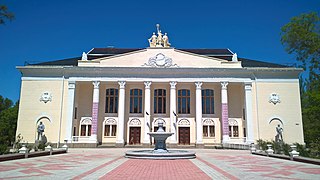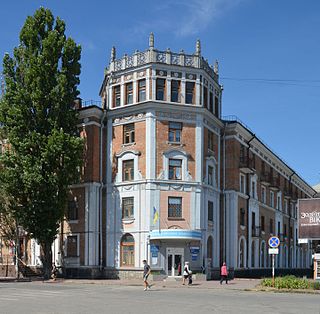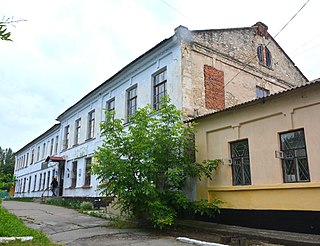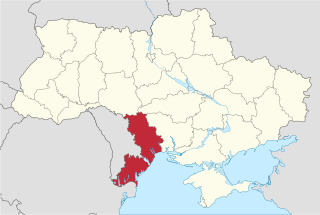
A kurgan is a type of tumulus constructed over a grave, often characterized by containing a single human body along with grave vessels, weapons, and horses. Originally in use on the Pontic–Caspian steppe, kurgans spread into much of Central Asia and Eastern, Southeast, Western, and Northern Europe during the third millennium BC.

The Dnieper, also called Dnepr or Dnipro, is one of the major transboundary rivers of Europe, rising in the Valdai Hills near Smolensk, Russia, before flowing through Belarus and Ukraine to the Black Sea. Approximately 2,200 km (1,400 mi) long, with a drainage basin of 504,000 square kilometres (195,000 sq mi), it is the longest river of Ukraine and Belarus and the fourth-longest river in Europe, after the Volga, Danube, and Ural rivers.

Nova Kakhovka is a city in Kakhovka Raion, Kherson Oblast, southern Ukraine. Nova Kakhovka has been under Russian occupation since February 2022. Its estimated population in 2022 was 44,427.

Kherson Oblast, also known as Khersonshchyna, is an oblast (province) in southern Ukraine. It is located just north of Crimea. Its administrative center is Kherson, on the northern or right bank of the Dnieper river, which bisects the oblast. The oblast has an area of 28,461 km2 and a population of 1,001,598. It is considered the 'fruit basket' of the country, as much of its agricultural production is dispersed throughout the country, with production peaking during the summer months.

Nikopol is a city and municipality (hromada) in Nikopol Raion in the south of Ukraine, on the right bank of the Dnipro/Dnieper River, about 63 km south-east of Kryvyi Rih and 48 km south-west of Zaporizhzhia. Population: 105.160.

Kakhovka is a port city on the Dnieper River in Kakhovka Raion, Kherson Oblast, of southern Ukraine. It hosts the administration of the Kakhovka urban hromada, one of the hromadas of Ukraine. It had a population of 34,749.

Kamianka-Dniprovska is a city in Zaporizhzhia Oblast, Ukraine. It served as the administrative center of the former Kamianka-Dniprovska Raion until that raion was merged into Vasylivka Raion in 2020. Population: 12,117.

Oleshky, previously known as Tsiurupynsk from 1928 to 2016, is a city in Kherson Raion, Kherson Oblast, southern Ukraine, located on the left bank of the Dnieper River with the town of Solontsi to the south. It is the oldest city of the oblast and one of the oldest in southern Ukraine. It is known for its proximity to the Oleshky Sands, a large desert region. Oleshky is the site of artist Polina Rayko's home, a national cultural monument of Ukraine. It also hosts the administration of Oleshky urban hromada, one of the hromadas of Ukraine. It had a population of 24,124.
Tavriisk is a small city in Kakhovka Raion, Kherson Oblast, southern Ukraine, close to the city of Nova Kakhovka. It is located on the left bank of the Dnieper River. Tavriisk hosts the administration of the Tavriisk urban hromada, one of the hromadas of Ukraine. It has a population of 10,108.

Enerhiya Nova Kakhovka was a Ukrainian professional football team from Nova Kakhovka in Kherson oblast. The club competed in the Ukrainian Second League since 2010.
Chaplynka is a rural settlement in Kakhovka Raion, Kherson Oblast, southern Ukraine. It hosts the administration of the Chaplynka settlement hromada, one of the hromadas of Ukraine. It had a population of 9,415. In early 2022, it came under Russian occupation as a result of the Russian invasion of Ukraine.

Beryslav Raion is one of the five administrative raions of Kherson Oblast in southern Ukraine. Its administrative center is located in the city of Beryslav. Its population was 55,976 as of the 2001 Ukrainian Census. Current population: 94,103.

Kakhovka Raion is one of the administrative raions of Kherson Oblast in southern Ukraine. Its administrative center is located in the city of Nova Kakhovka. Population: 216,458.

The North Crimean Canal, formerly known as the North Crimean Canal of the Lenin's Komsomol of Ukraine in Soviet times, is a land improvement canal for irrigation and watering of Kherson Oblast in southern Ukraine and the Crimean Peninsula. The canal has multiple branches throughout Kherson Oblast and Crimea, and is normally active from March until December.

Bilozerka is a rural settlement in Kherson Raion, Kherson Oblast, southern Ukraine. It hosts the administration of Bilozerka settlement hromada, one of the hromadas of Ukraine. It has a population of 9,258.

Novovorontsovka is a rural settlement in Beryslav Raion, Kherson Oblast, southern Ukraine. It hosts the administration of Novovorontsovka settlement hromada, one of the hromadas of Ukraine. Novovorontsovka is located on the right bank of the Kakhovka Reservoir, an artificial reservoir on the Dnieper. It has a population of 5,951.

Odesa Oblast, also referred to as Odeshchyna (Одещина), is an oblast (province) of southwestern Ukraine, located along the northern coast of the Black Sea. Its administrative centre is the city of Odesa. Population: 2,351,382.
Kozatske is a rural settlement in Kakhovka Raion, Kherson Oblast, southern Ukraine. It is located on the right bank of the Dnieper, separated from Nova Kakhovka on the left bank by the dam of the Kakhovka Hydroelectric Power Plant. Kozatske belongs to Nova Kakhovka urban hromada, one of the hromadas of Ukraine. It has a population of 3,653.
Dnipriany, known as Brytany before 1946, is a rural settlement in Kakhovka Raion, Kherson Oblast, southern Ukraine. It is located on the left bank of the Dnieper, about 10 kilometres (6.2 mi) downstream of the city of Nova Kakhovka. Dnipriany belongs to Nova Kakhovka urban hromada, one of the hromadas of Ukraine. It has a population of 3,930.
Zelenyi Pid is a village in Kakhovka Raion, Kherson Oblast, Ukraine. The village hosts the administration of the Zelenyi Pid rural hromada, one of the hromadas of Ukraine.

















